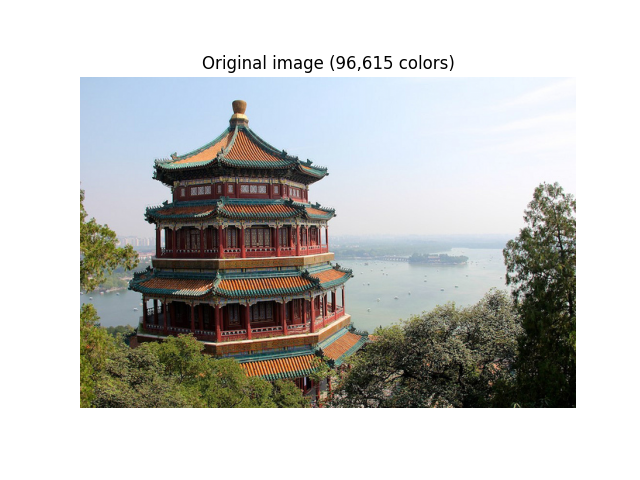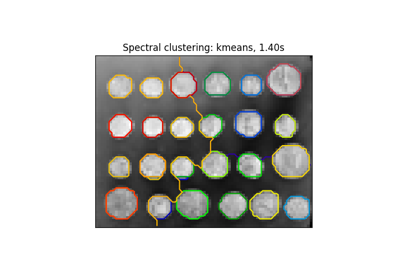Note
Go to the end to download the full example code. or to run this example in your browser via Binder
使用K均值的颜色量化#
对颐和园(中国)图像执行逐像素的矢量量化(VQ),将显示图像所需的颜色数量从96,615种独特颜色减少到64种,同时保留整体外观质量。
在此示例中,像素在3D空间中表示,并使用K均值找到64个颜色簇。在图像处理文献中,从K均值获得的代码簿(簇中心)称为调色板。使用单字节最多可以表示256种颜色,而RGB编码每个像素需要3个字节。例如,GIF文件格式使用这种调色板。
为了比较,还显示了使用随机代码簿(随机选择颜色)的量化图像。
Fitting model on a small sub-sample of the data
done in 0.010s.
Predicting color indices on the full image (k-means)
done in 0.031s.
Predicting color indices on the full image (random)
done in 0.012s.
# 作者:scikit-learn 开发者
# SPDX 许可证标识符:BSD-3-Clause
from time import time
import matplotlib.pyplot as plt
import numpy as np
from sklearn.cluster import KMeans
from sklearn.datasets import load_sample_image
from sklearn.metrics import pairwise_distances_argmin
from sklearn.utils import shuffle
n_colors = 64
# 加载颐和园照片
#
#
china = load_sample_image("china.jpg")
# 转换为浮点数,而不是默认的8位整数编码。除以255很重要,这样plt.imshow在处理浮点数据时才能正常工作(需要在[0-1]范围内)。
china = np.array(china, dtype=np.float64) / 255
# 加载图像并转换为二维 numpy 数组。
w, h, d = original_shape = tuple(china.shape)
assert d == 3
image_array = np.reshape(china, (w * h, d))
print("Fitting model on a small sub-sample of the data")
t0 = time()
image_array_sample = shuffle(image_array, random_state=0, n_samples=1_000)
kmeans = KMeans(n_clusters=n_colors, random_state=0).fit(image_array_sample)
print(f"done in {time() - t0:0.3f}s.")
# 获取所有点的标签
print("Predicting color indices on the full image (k-means)")
t0 = time()
labels = kmeans.predict(image_array)
print(f"done in {time() - t0:0.3f}s.")
codebook_random = shuffle(image_array, random_state=0, n_samples=n_colors)
print("Predicting color indices on the full image (random)")
t0 = time()
labels_random = pairwise_distances_argmin(codebook_random, image_array, axis=0)
print(f"done in {time() - t0:0.3f}s.")
def recreate_image(codebook, labels, w, h):
"""从代码簿和标签中重建(压缩的)图像"""
return codebook[labels].reshape(w, h, -1)
# 显示所有结果,并列出原始图像
plt.figure(1)
plt.clf()
plt.axis("off")
plt.title("Original image (96,615 colors)")
plt.imshow(china)
plt.figure(2)
plt.clf()
plt.axis("off")
plt.title(f"Quantized image ({n_colors} colors, K-Means)")
plt.imshow(recreate_image(kmeans.cluster_centers_, labels, w, h))
plt.figure(3)
plt.clf()
plt.axis("off")
plt.title(f"Quantized image ({n_colors} colors, Random)")
plt.imshow(recreate_image(codebook_random, labels_random, w, h))
plt.show()
Total running time of the script: (0 minutes 0.327 seconds)
Related examples








